
Original Link: https://www.anandtech.com/show/2856
AMD’s Radeon HD 5770 & 5750: DirectX 11 for the Mainstream Crowd
by Ryan Smith on October 13, 2009 12:00 AM EST- Posted in
- GPUs
4 chips in 6 months.
This is the schedule AMD’s GPU engineering teams committed themselves to for the launch of the Evergreen family. The entire family from top to bottom would be launched in a 6 month period.
Last month AMD took the first step of that plan with the launch of Cypress, the forebear of the family and the source of the Radeon HD 5870 and 5850. Today AMD is taking the next step in the launch of the Evergreen family by delivering the 2nd and final Evergreen chip of the year: Juniper. Or as the products based off of them are known as, the Radeon HD 5770 and 5750.
| ATI Radeon HD 5870 | ATI Radeon HD 5850 | ATI Radeon HD 5770 | ATI Radeon HD 5750 |
ATI Radeon HD
4870
|
ATI Radeon HD
4850
|
|
| Stream Processors | 1600 | 1440 | 800 | 720 | 800 | 800 |
| Texture Units | 80 | 72 | 40 | 36 | 40 | 40 |
| ROPs | 32 | 32 | 16 | 16 | 16 | 16 |
| Core Clock | 850MHz | 725MHz | 850MHz | 700MHz | 750MHz | 625MHz |
| Memory Clock | 1.2GHz (4.8GHz data rate) GDDR5 | 1GHz (4GHz data rate) GDDR5 | 1.2GHz (4.8GHz data rate) GDDR5 | 1.15GHz (4.6GHz data rate) GDDR5 | 900MHz (3600MHz data rate) GDDR5 | 993MHz (1986MHz data rate) GDDR3 |
| Memory Bus Width | 256-bit | 256-bit | 128-bit | 128-bit | 256-bit | 256-bit |
| Frame Buffer | 1GB | 1GB | 1GB | 1GB / 512MB | 1GB | 1GB / 512MB |
| Transistor Count | 2.15B | 2.15B | 1.04B | 1.04B | 956M | 956M |
| TDP | 188W | 151W | 108W | 86W | 150W | 110W |
| Manufacturing Process | TSMC 40nm | TSMC 40nm | TSMC 40nm | TSMC 40nm | TSMC 55nm | TSMC 55nm |
| Price Point | $379 | $259 | $159 | $129 / $109 | $140-$160 | $109-$129 |
In our 5800 series launch article, we briefly discussed Juniper and the other members of the Evergreen family. With Cypress a bit too big and a bit too expensive to hit mainstream prices, a new chip was introduced in to AMD’s usual 3 chip stack to cover that segment of the market, and that chip was Juniper.
What’s Juniper? In a nutshell, it’s all of Cypress’ features with half the functional units (and no Double Precision for you scientist types). DirectX 11, Eyefinity, angle-independent anisotropic filtering, HDMI bitstreaming, and supersample anti-aliasing are all accounted for. For more information on these features, please see our Radeon 5870 launch article from last month.
With half of the functional units left behind, we’re left with 10 SIMDs, giving us 800 stream processors and 40 texture units, while the ROP count has also been cut in half to 16, in turn giving us a 128-bit memory bus. If Cypress was 2 RV770s put together, then Juniper is the closest thing you’re going to see to RV770 coming out of the Evergreen family.

Juniper
With the reduction in functional units, Juniper becomes a leaner and meaner core. The transistor count is 1.04 billion, a little less than half of Cypress and about 100 million more than RV770. The die size of this resulting core is 166mm2, significantly less than both Cypress and RV770, the latter due to the smaller process size. RV770 for comparison was 260mm2.
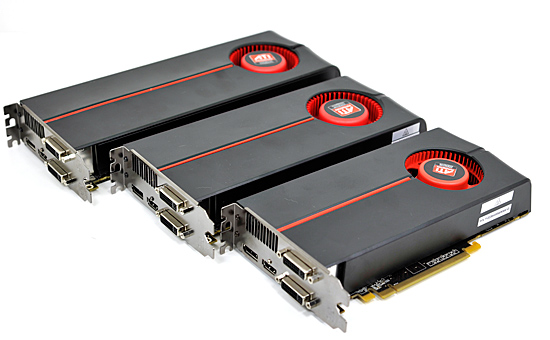
From Juniper we are getting the 5770 and the 5750. The 5770 is a full Juniper, with all of Juniper’s functional units enabled and the card running at what amounts to a full speed of 850MHz (the same as 5850). The 5750 is slightly cut down, much like 5850 is compared to 5870. Here we have 1 SIMD disabled, and the core clock reduced to 700MHz. This is a notable departure from how AMD handled the 4870/4850 split, where 4850 was differentiated using a slightly slower core and much slower RAM, without the need to disable any SIMDs.
The smaller Juniper core also affords these cards lower power usage than the 5800 series. The 5770 is 108W at load and 18W at idle, meanwhile the 5750 is 86W at load and 16W at idle.
As an interesting aside, when AMD started sampling Evergreen cards to game development houses and other 3rd parties, they were Juniper based, and not Cypress based. The Juniper team was rather proud of this, particularly since Juniper came back from TSMC second. They also had less time to get their GPU up and working than the Cypress team did, since they had to wait on Cypress before being able to finish work on some elements. This is what makes AMD’s 6 month rollout all the more impressive, since it means the non-Cypress teams had less time to get their work done than they have in previous product cycles.
Meet The 5770
We’ll start our look at today’s cards with the 5770. As we mentioned previously the 5770 is the full speed Juniper card, with all 10 SIMDs enabled, and clocked at 850MHz for the core and 1.2Ghz (4.8GHz data rate) GDDR5 for the RAM. As has become the current standard for just about every card over $100 these days, the card is equipped with 1GB of RAM. Attaching this RAM to the GPU is a 128-bit bus, giving the card 76.8GB/sec of memory bandwidth. The use of such fast RAM strikes our interest in particular, since it means vendors are spending just as much to equip a 5770 with RAM as they are a 5870.
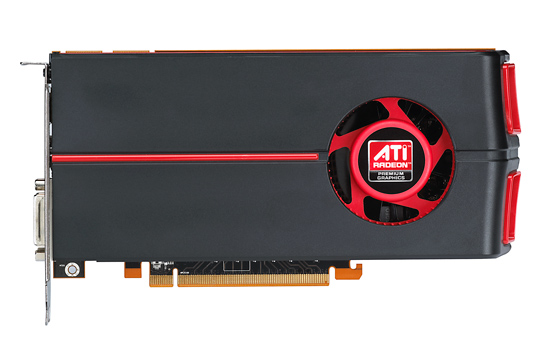
For cooling, the 5770 uses the same general plastic shroud as the 5800 series cards, which AMD’s 5700 team told us is called the Phoenix. Here the shroud hangs over the rear of the card by just less than half an inch, making it more like the 5870 than the 5850 where the shroud stopped at the edge of the card. The length of the card is 8.25”, adding the shroud brings it to just shy of 8.75”.
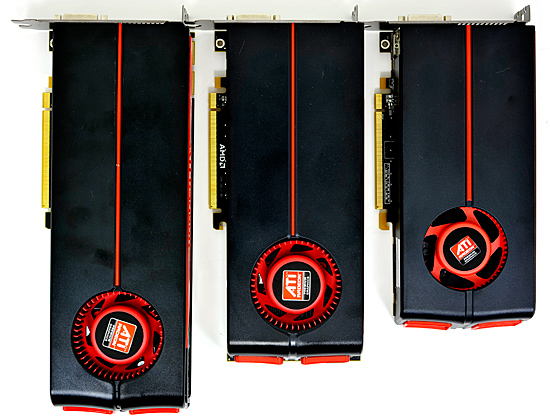
5870, 5850, 5770
Interestingly enough, we’ve been told that the Phoenix shroud isn’t going to be sticking around for long. The first wave of cards launching today and for the near future will be using the shroud, but once AMD’s vendors begin using their own designs, AMD doesn’t expect most of the vendors to stick with the shroud. XFX has specifically been named as a party that will keep using the shroud on products, but anyone else is subject to change. With a TDP of only 108W, the Phoenix shroud is probably overbuilt and certainly more expensive than vendors would like, where mainstream products come with thinner margins. We would expect the vendors that do switch to move to more traditional dual-slot coolers, likely ones that aren’t shrouded at all and would not blow hot air outside of the case.
While we were fine with the shroud on the 5800 series, we do take slight issue with it on the 5770. Because the single 6-pin PCIe power connector on this card is on the rear of the card, the shroud is in the way of the PCIe power connector. This wasn’t an issue on the 5870 since the power connectors were on top, and on the 5850 the shroud stopped at the end of the card. But here the extra shroud makes it much harder to see what you’re doing when it comes to plugging in a PCIe power connector unless you’re looking at the rear of the card, and it makes it a bit harder to remove a PCIe power plug once placed.
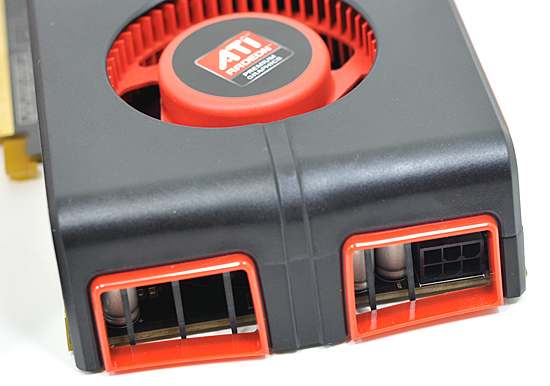
AMD made it clear to us that they did consider this in the design of the 5770, and to their credit the shroud never makes inserting/removing a PCIe power plug impossible, but that doesn’t mean we have to like it. We would have liked to see the shroud go the same length as the card, so that it would be just as easy to use as the 5850.
At any rate, along with keeping the 5800 series shroud, the 5770 keeps the port configuration. 1 DisplayPort, 1 HDMI port, and 2 DVI ports make up the card’s output options. This is intentional on the part of AMD, as they want to push Eyefinity on these cards just as much as they do on their high-end products, which means they want to use the same ideal configuration. We wouldn’t be shocked to see this modified at the same time as vendors dropping the shroud though; 1 DVI, 1 HDMI, and 1 DisplayPort with a flexible HDMI->DVI adapter is a likely configuration.

The price of DisplayPort->DVI dongles rears its head once again here, and even more severely. DisplayPort monitors are still rare, so the most likely Eyefinity configuration is going to be 3x DVI, which is going to require a dongle. Those dongles are still going for $100+ right now, which is a significant fraction of the price of the card itself. We talked to AMD about this issue, but it’s something that’s out of their hands for the moment.
AMD is pricing this card at $159. This puts it in competition with the cheapest GTX 260s from NVIDIA, and AMD’s 4870, the latter of which tends to sell for only $10 less for the 1GB version. AMD wouldn’t give us a clear idea on how long they expect the 4870 to last, but it seems clear that they intend to phase out the 4870 with the 5770. This may not be such a great idea, but we’ll get to that after we take a look at performance.
Notably, this leaves a $100 pricing hole in AMD’s 5000-series product lineup, since the next card up is the $259 5850. AMD pointed out to us that this is by no means unprecedented (the 4800 series launch saw a $100 gap between the 4870 and 4850) but we’re not used to seeing such a gap in recent times. This price gap makes a little more sense with AMD’s target demographics: the 5800 series is for 2560x1600 gaming, while the 5770 is targeted for 1920x1200/1080. So as far as they’re concerned, there isn’t a demographic gap to make the price gap a problem.
Anyhow, for the time being, the 4890 will function as a slight bridge on that pricing gap. It will continue to occupy a range around $180-$200.
For today’s launch, availability is expected to be in the “tens of thousands” of units. We suspect that the situation is going to mirror the 5870 launch (tight availability at first) but we’ll see. For this launch period, AMD is also extending the DIRT 2 freebie offer to vendors that want to include it with their 5770 cards. So most if not all cards will come with a voucher for this game to get it in December.
Meet The 5750
Below the 5770, we have the 5750, the other card being launched today. This is a 700MHz card with 1 SIMD disabled, and the memory clock at 1.15GHz(4.6GHz effective). This represents an 18% decrease in core clock and the performance of all units tied to that clock, and a 10% further reduction in computational and texturing power due to the loss of a SIMD, for a total theoretical performance reduction of 26%. The ROP count remains unchanged at 16.
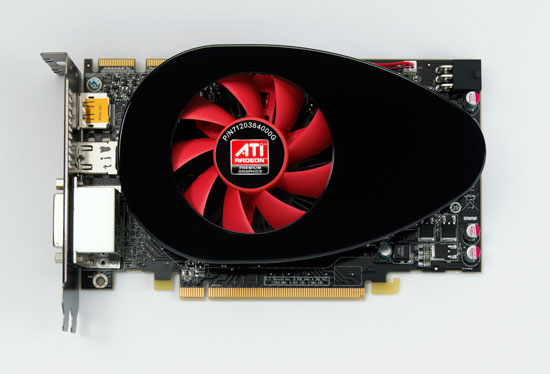
The 5750 will come with either 512MB or 1GB of RAM, depending on the target price, with no change in memory clocks. As is the case with 5770, we find the choice of memory speeds interesting since vendors still have to use the same speed RAM on the 5750 as they do the 5870 (boy this stuff must be cheap). No one makes 1.15GHz GDDR5, so vendors have no choice but to equip it with something faster. Our samples are using Hynix 1.25GHz modules, which means the 5750 and the 5770 should be capable of some easy memory overclocking (bus capabilities withstanding). At the moment no one makes 1.2GHz modules, so this may persist for some time.
Compared to the 5770, gone is the expensive Phoenix shroud, replaced with what we’re calling the “egg”. The egg is a simple circular heatsink with a 2-pin fan embedded in it, which sucks in air and pushes it out along the fins. The egg shape is brought about by the plastic cover at the top of the heatsink – we’re not sure if it’s just for looks or if it’s accomplishing some specific function. The card length is 7.15 inches, with no shroud to extend that.

Once again we’ll see the same Eyefinity port configuration here; 1 DisplayPort, 1 HDMI, and 2 DVI. There’s still a half-slot vent here, but since the design of the cooler means that the card is blowing hot air in to the case instead of out the rear, it serves more as a window to look at the card. As a card with this performance level isn’t a good choice for gaming with Eyefinity, AMD is shooting at professional users with the Eyefinity capabilities of this card. We expect that this will be a bit harder of a sale, since Single Large Surface capabilities aren’t as critical with windowed programs, and the high price of DisplayPort->DVI dongles means that the dongle is as much as the card.
We should also note that it’s the desire to keep the Eyefinity port configuration that lead to the use of the egg cooler. For the second generation of cards, vendors are likely to drop the egg cooler for a single-slot cooler. Certainly the 5750 is cool enough at 86W TDP that it doesn’t need a dual-slot cooler.
For pricing, AMD is putting the 1GB version of this card at $129, and the 512MB version at $109. This puts it in competition with NVIDIA’s GTS 250 cards, and AMD’s 4850 cards. Unlike the 5770, the price here is certainly right, as we’ll see later.
As is the case with the 5770, the 5750 is expected to have “tens of thousands” of units available at launch, with any supply constraints likely to be the same between the two. The 1GB cards will come with DIRT 2 vouchers if the vender participates, the 512MB cards will not.
The Test
For the 5700 series launch, AMD issued some new drivers as the previous 8.66 driver set did not include support for these cards. The driver set we used for these cards is 8.66.6, which is from the same branch as the earlier drivers. In our own testing, we haven’t seen any performance differences between these drivers and the previous ones on the 5800 series cards, but AMD did note that certain configurations might see a small performance boost. As such our results are still using the original 8.66 driver for the 4000 and 5800 series.
Also, as AMD sent us a pair of 5770s, we have tested these cards in a Crossfire configuration. This configuration is largely academic, as 2 5770s is just shy of the price of a 5870 and brings with it all of the limitations of multi-GPU scaling as compared to single-GPU scaling.
On a final note, our 5750 sample is a 1GB card.
| CPU: | Intel Core i7-920 @ 3.33GHz |
| Motherboard: | Intel DX58SO (Intel X58) |
| Chipset Drivers: | Intel 9.1.1.1015 (Intel) |
| Hard Disk: | Intel X25-M SSD (80GB) |
| Memory: | Patriot Viper DDR3-1333 3 x 2GB (7-7-7-20) |
| Video Cards: |
ATI Radeon HD 5870 |
| Video Drivers: |
NVIDIA ForceWare 190.62 |
| OS: | Windows 7 Ultimate 64-bit |
Crysis: Warhead
Kicking things off, we’ll start with Crysis: Warhead. Warhead is still the single most demanding game in our arsenal, with cards continuing to struggle to put out a playable frame rate with everything turned up.
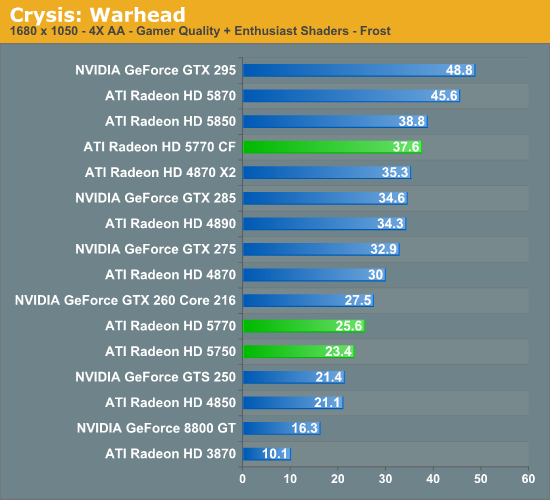
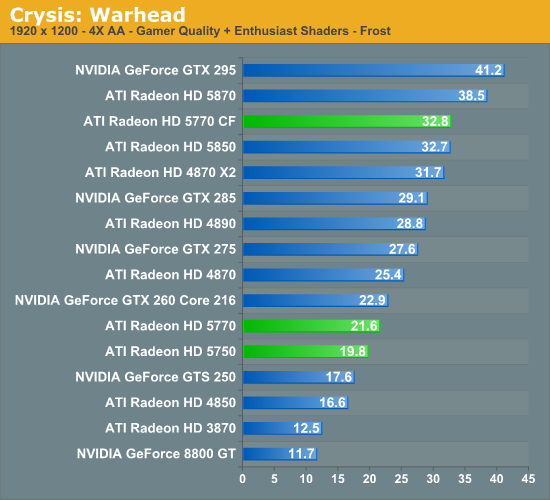
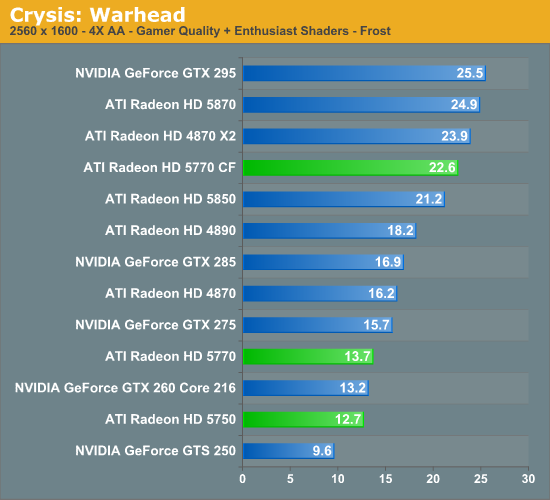
Update: As a few of you pointed out, there was something a bit off with our Crysis results; we had a Radeon 4850 beating the 5770. As it turns out we wrote down the maximum framerate for the 4850 instead of the average framerate. None of the other results were affected, and this has been corrected. Sorry, folks.
There are a few different situations we’re going to be interested in. The first is the matchup between the 5770, the 4870, and the GTX 260. The second is the matchup between the 5750, the 4850, and the GTS 250. The third is the 5770 as compared to the 5800 series, in order to see what another $100 or $200 is buying you in the Evergreen family.
Unfortunate for the 5770, this is not a game that treats it well. In spite of the clock speed advantage over the 4870, and the architectural advantages (extra caches and what-not), it underperforms the 4870 by about 15% here. AMD had once told us that they believed that they weren’t memory bandwidth constrained on the 4870/4890, but when that’s the only significant difference between the 5770 and the 4870 that would explain the performance difference (certainly Juniper wouldn’t be slower than RV770), we are beginning to doubt that. Meanwhile the GTX 260 outscores the 5770 here too.
Looking at the 5770 compared to the 5850, $100 buys you roughly 50% more performance.
The 5750 fares much better here. It beats the 4850 by 10%-20%, and beats the GTS 250 by a similar margin.
Far Cry 2
Far Cry 2 is another foliage-heavy game. Thankfully it’s not nearly as punishing as Crysis, and it’s possible to achieve a good framerate even with all the settings at their highest.
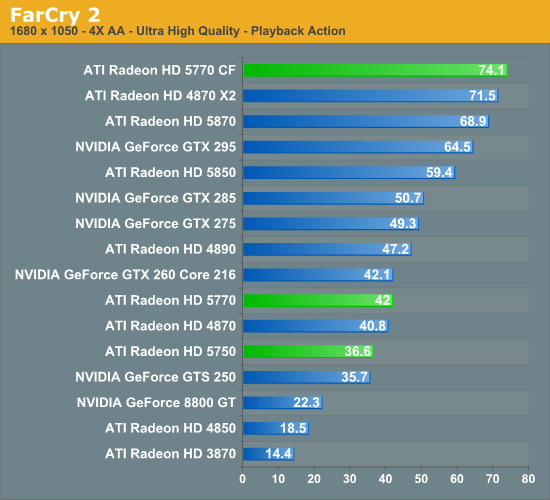
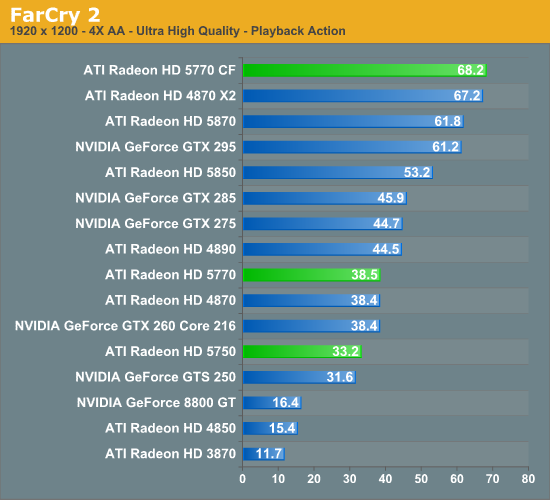
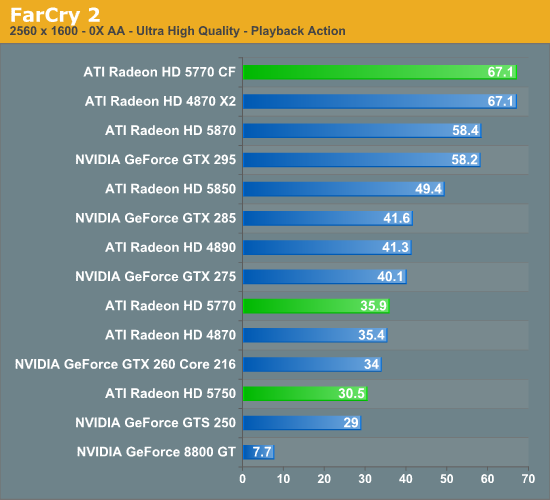
Update: When we first published this article, we had some anomalously high results for the 5770 at 1680 and 1920. We have found the reason for this and corrected it. This brings the 5770's scores down by 10fps or so.
Compared to Crysis: Warhead, Far Cry 2 paints a better picture for the 5770. Here it just manages to beat out our 4870, which may be slightly disappointing for those of you that are expecting a decisive victory over the 4870, but it's better than a loss like in Crysis. The GTX 260 is also neck-and-neck with our two Radeon cards here.
Far Cry 2 also paints an interesting case for the 5750 in comparison to the 4850. Far Cry 2 likes RAM, particularly on AMD cards. With the 1GB on our 5750, it doubles the terrible performance of the 4850. This is going to be the exception to the norm here though.
Finally, with the solid performance of the 5770, a 5850 buys around 40% performance improvement here.
BattleForge
BattleForge is EA’s card-based online-only RTS. As the first DirectX11 title it’s of particular importance for the latest rendition of DirectX, although in this case we aren’t using any features that would be impacted by it. Even without ambient occlusion, BattleForge manages to be a rather punishing game for GPUs.
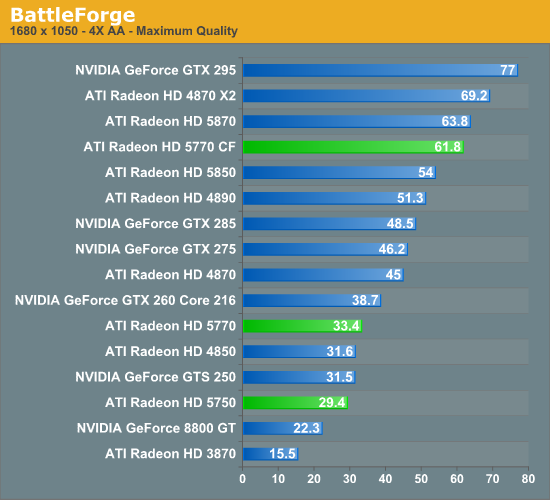
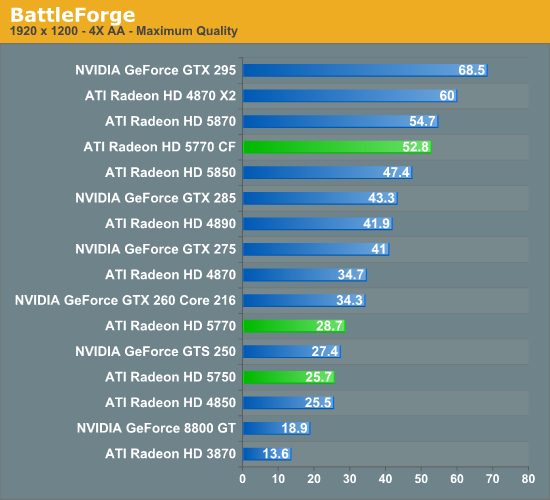
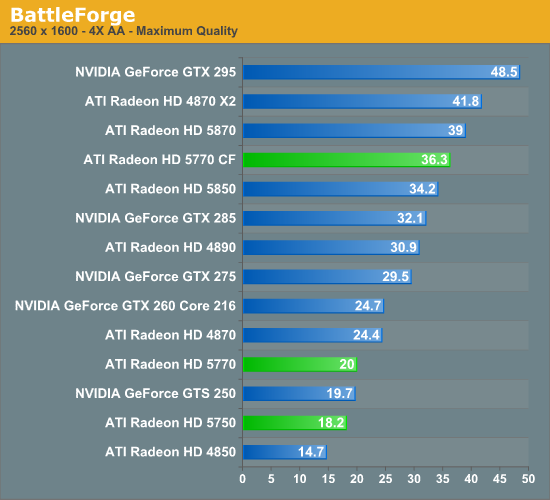
BattleForge is another game that punishes the 5700 series. The performance hit coming from the 4870 starts at 25% at 1680, and ends at just 18% at 2560. This also means that the 5770 loses to the GTX 260.
As for the 5750, it loses at 1680 by 7%, but eeks out a very slight win at 1920. Apparently being memory bandwidth starved isn’t so bad when your competitor is too.
Finally, this gives us one of the larger gaps between the 5770 and 5850. $100 buys you 60%-70% more performance.
HAWX
HAWX is another game that’s not particularly GPU-bound, which means we can turn in some high numbers.


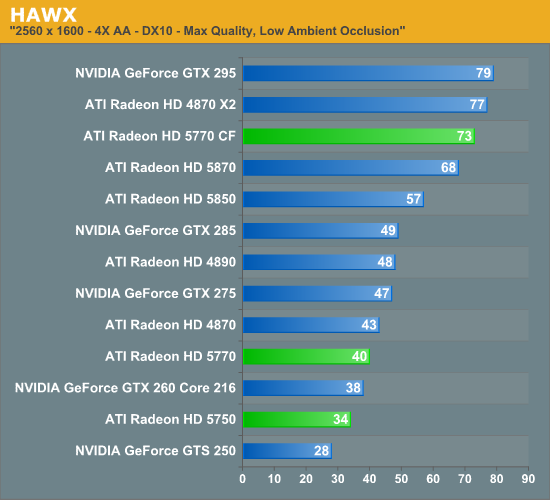
The 5770 fares better at HAWX. Not good, but better. As compared to the 4870, we lose around 10%. The situation versus the GTX 260 isn’t very good however.
With the 5750, we have a break-even proposition. It loses one resolution and wins another by roughly the same amounts. It also does rather well here against the GTS 250 at 2560.
Meanwhile that $100 more on a 5850 only gets you 30%-40% more performance. We’re probably approaching a CPU-bound situation here.
Dawn of War II
Dawn of War II is our other RTS benchmark. It’s among the more challenging games in our collection, leading to there being a definite cutoff for playability.
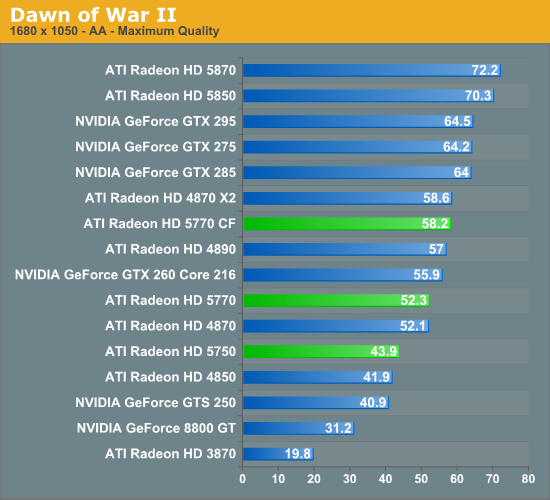
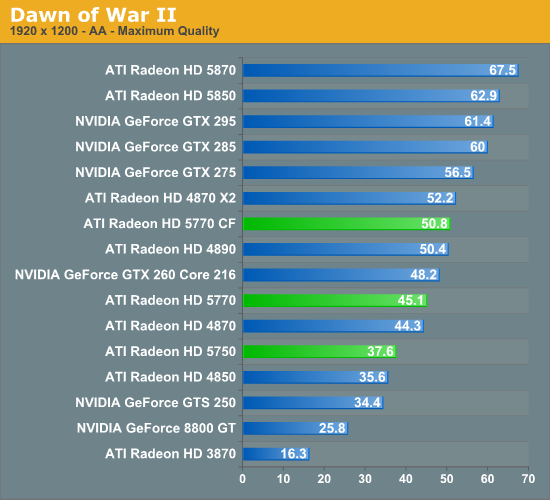

And the 5770 finally wins at something! It’s a couple percent over the 4870 at best, but it’s something. The GTX 260 still claims top honors though.
As for the 5750, it pulls off a respectable lead as compared to the 4850, by about 5%. The GTS 250 again loses here.
As for that 5850, $100 buys you up to 56% more, at the highest resolutions.
Resident Evil 5
As is often the case with console ports, the latest installment of Capcom’s popular survival horror series is not particularly GPU starved, and can crank out high numbers on just about anything.
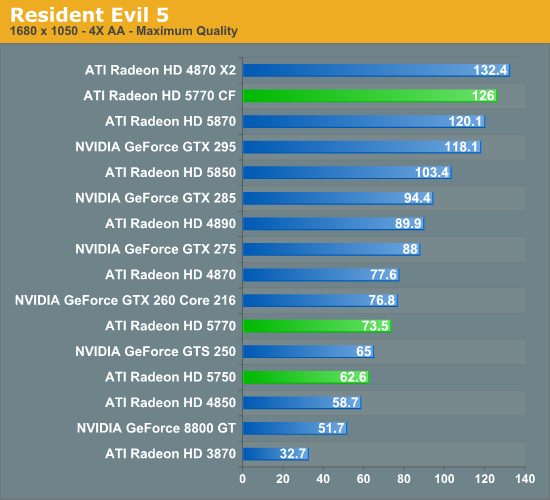
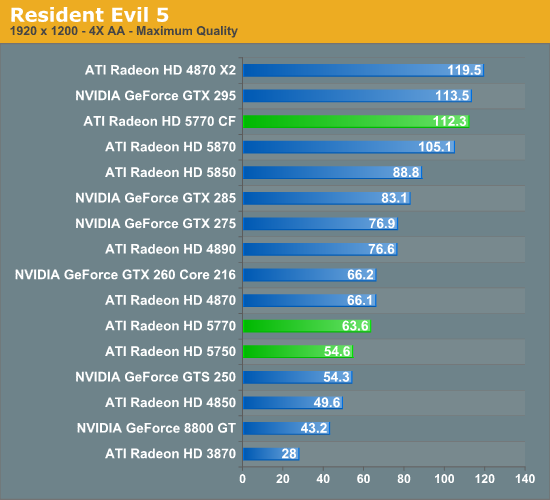
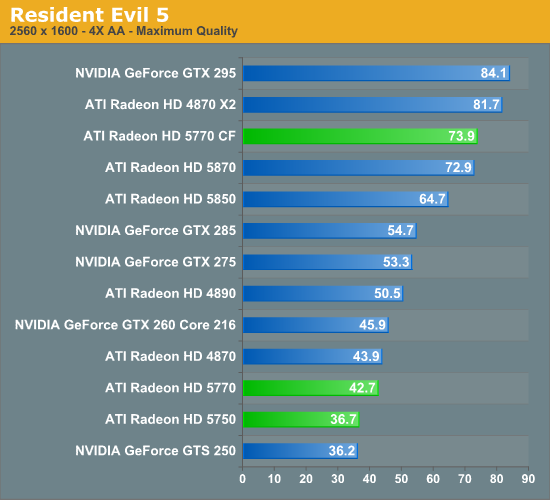
The 5770 goes back to losing, but this time it’s only by a few percent. The GTX 260 wins here yet again though.
It’s another win for the 5750 though; 6-10%. It and the GTS 250 are virtually indistinguishable above 1680.
Finally, another $100 on a 5850 buys you 40%-50% more performance.
Batman: Arkham Asylum
Batman: Arkham Asylum is another brand-new PC game, and has been burning up the review charts. It’s an Unreal Engine 3 based game, something that’s not immediately obvious from just looking at it, which is rare for UE3 based games.
As Batman: Arkham Asylum implements anti-aliasing differently between AMD and NVIDIA cards, this is the one title that we do not test AA on, as doing so produces results that can’t be compared.
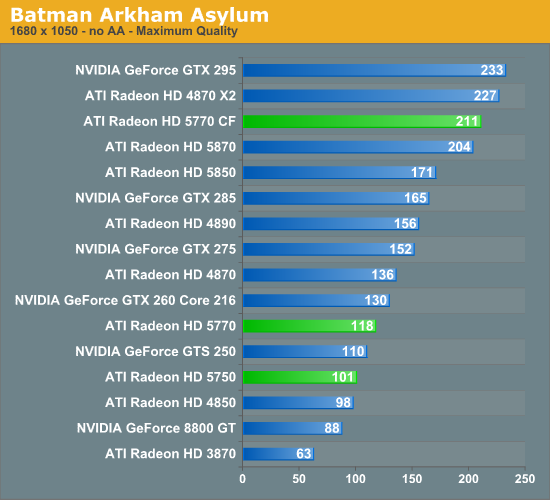
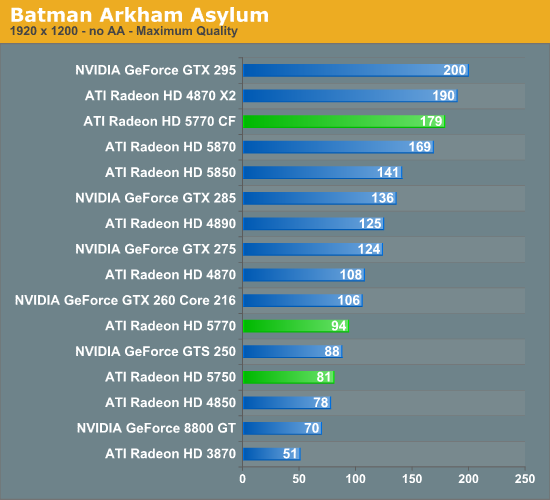

The 5770 goes back to losing by a wider margin compared to the 4870, roughly 10% this time. The story of it compared to the GTX 260 is also the same, with another GTX 260 win.
Meanwhile the 5750 gets another win over the 4850, although this is one of the only times it loses to the GTS 250.
Finally, a 5850 will buy you another 45%-55% in performance, for $100.
Left 4 Dead
Valve’s venerable Source engine continues to roll on with Left 4 Dead, their co-op zombie shooter. As the Source engine is CPU limited, this is once again going to be a collection of ridiculously high frame rates.
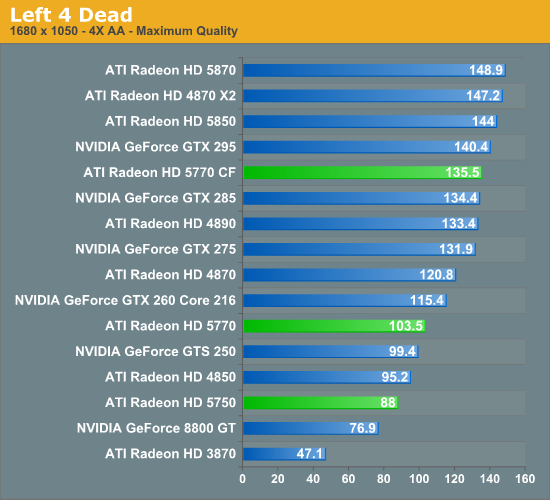
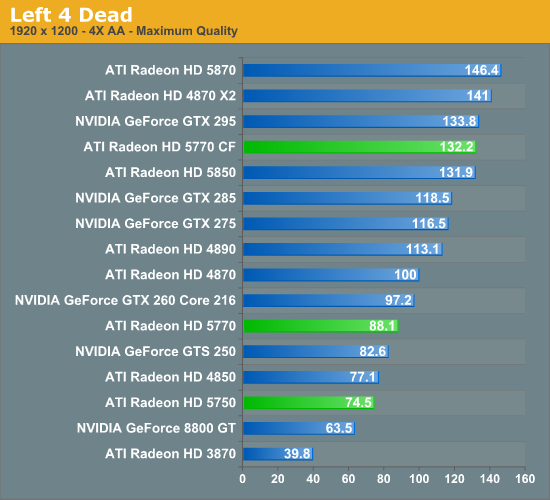
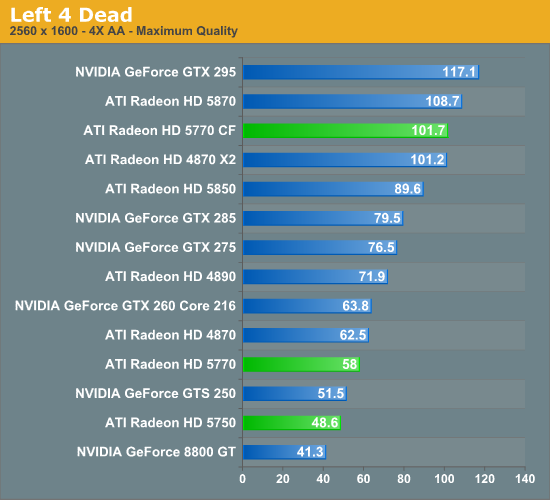
More losing all around. The 5770 and 5750 here lose against their 4800 series cousins by roughly 10% and 5% respectively. The GTX 260 and GTS 250 are also winners here.
Meanwhile a 5850 comes in at 40%-55% faster.
Power, Temperature, & Noise
With the 5700 series being built using TSMC’s 40nm process, and with their low target power, we should see some interesting results here.
We do need to note however that thanks to some badly timed broken hardware, we’re using our secondary test rig for noise and temperature data, so the results are not directly comparable to our 5800 series reviews. As a result we also only have power data for the 5770; we weren’t able to get power data on the 5750 in time for this article.
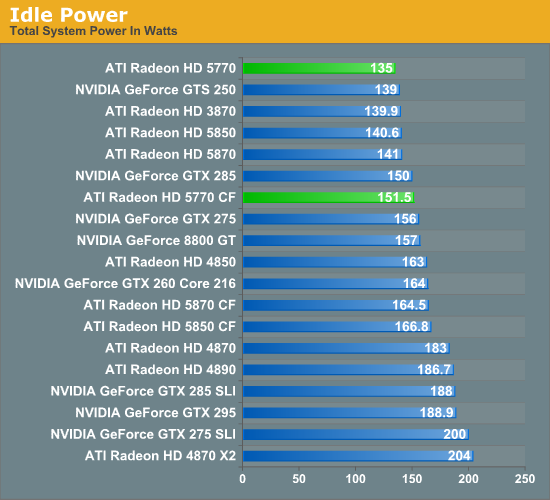
Thanks to the 40nm process and relatively simple nature of Juniper, the 5770 turns in the best idle power usage of all of our mainstream and high-end cards. At 135W it edges out the GTS 250, the 3870, and its bigger brothers the 5800 series. Coupled with a good CPU, and this should result in a system with very good idle power usage for the performance levels it provides.
We can also see the low power usage of an individual 5770 in our 5770 CF usage. There's a 16.5W difference, as the slave card gets to power down even further than 18W.

At 256W for load power, the 5770 isn’t quite the winner here like it is for idle power. The 3870 beats it by 14W at the cost of a significant degree of performance, while the 8800GT is neck-and-neck with the 4770, again with a decent-sized performance gap. Everything past here approaches 300W and beyond. As a result, even if it’s not the least power hungry card we have, it’s very close, and it’s certainly among the best for on a power-to-performance ratio.
Meanwhile looking at the Crossfire results, we see that there's a 134W difference between cards. As the Evergreen architecture allows us to go higher so long as the VRMs are safe, this appears to that situation in action.
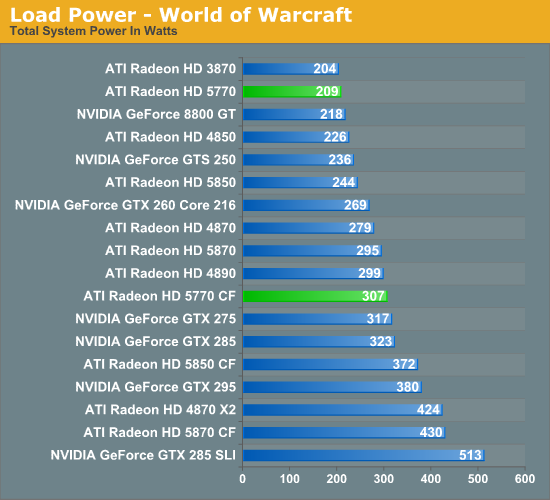
World of Warcraft gives us similar results. The 5770 still doesn’t come out on top, but its bested only by the 3870 and its significantly lower performance. The gap on the other side isn’t particularly large either, but the first card that can beat the 5770’s average gaming performance doesn’t show up until we hit the 5850.
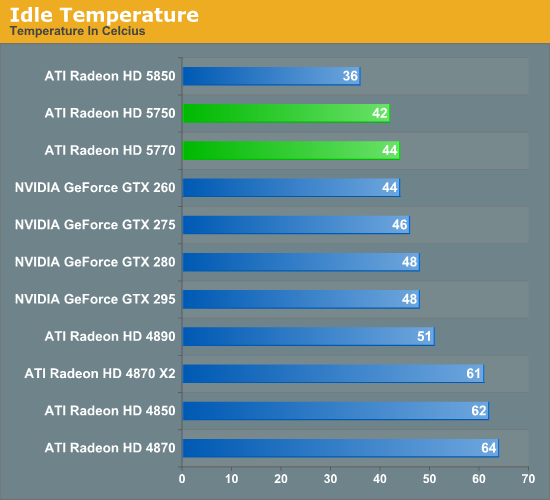
The 5700 series turns in some of our best idle temps, tying or beating everything besides a 5850. In fact we’re a bit surprised to see a 5850 win here given the lower idle power usage of the 5700 series, but the data doesn’t lie.
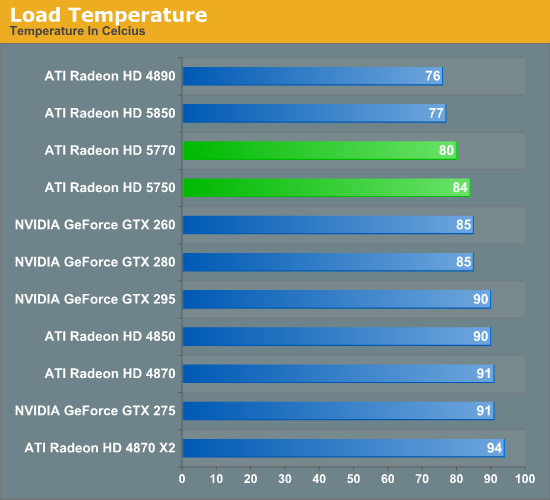
It’s load temperatures where all of the action is at. Again the 5700 series do quite well here, only losing to the 5850 and a very loud 4890. Compared to the rest of the 4800 series in particular, we’re a good 6C-11C cooler for a set of cards that offer similar to slightly less performance. Aren’t smaller manufacturing processes great?
However in spite of the 5750’s lower power consumption, it doesn’t do so well here in terms of temperature compared to the 5770, coming in 4C hotter. We’re going to chalk it up to the egg cooler being unable to match the 5770’s shrouded cooler. This of course makes the fact that the 5770’s shrouded cooler is going to eventually go away all the more meaningful, as conceivably the replacement coolers would end up being less effective.
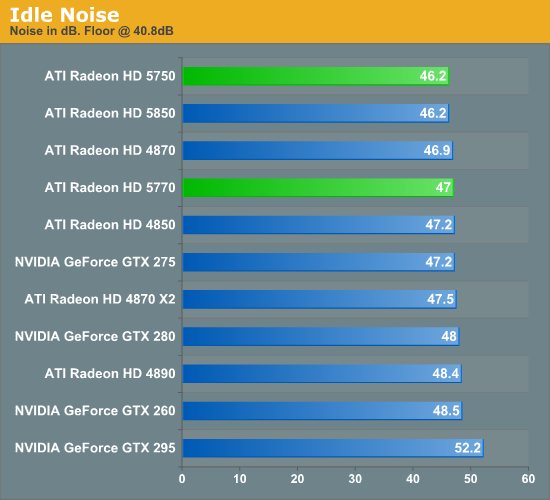
As is the case for most of the cards we test, at idle they’re virtually all the same. The 5700 series are no exception to this rule.
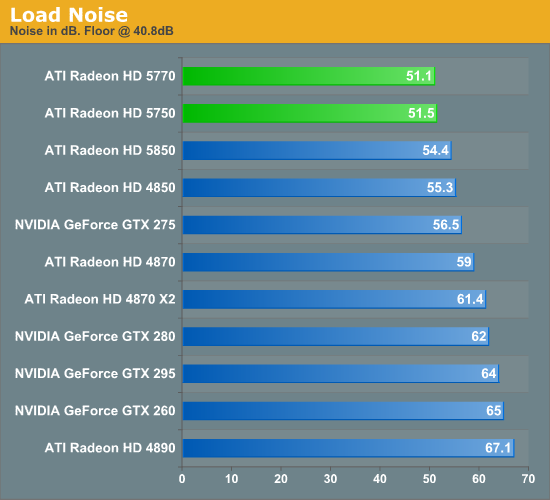
With the low power consumption of the 5700 series, their coolers don’t have to work very hard to reach their already low load temperatures. At 51dB, these are the quietest cards we’ve tested at this level of performance; we would need to drop down to something slower yet (like yesterday’s GT 220) to find something quieter.
We also can’t rule out the possibility of the 5750 going passive in the future, given its already dainty cooler. We’ve seen it done before on an 8800GT, which has a similar thermal envelope. This certainly has all the makings of the fastest passively cooled card on the market, if someone can build the right cooler.
This also leaves the door open to the idea of using the 5750 as an HTPC card. With bitstreaming audio support it’s the best HTPC card we’ve tested yet from a features standpoint, but we’re not convinced that it’s going to be the best thing out there given it’s >$100 price tag and the fact that it’s still power-hungry enough to need a PCIe power connector. In the long-term the 5600 series may be a better replacement given the same features and lower power consumption that a lower-performing part will offer, but that’s something we won’t be able to test until next year.
Conclusion
When we were looking at the Radeon HD 5800 series cards, writing a conclusion was rather easy for us. We didn’t need to talk about intangibles like Eyefinity or DirectX 11, because the 5800 series brought better performance at better prices for existing games. This made recommending the 5800 series a straightforward thing to do.
But we don’t have that luxury with the Radeon HD 5700 series. The value of the 5770 in particular is clearly not going to be in its performance. Compared to AMD’s 4870, it loses well more than it wins, and if we throw out Far Cry 2, it’s around 10% slower overall. It also spends most of its time losing to NVIDIA’s GTX 260, which unfortunately the 4870 didn’t have so much trouble with. AMD clearly has put themselves in to a hole with memory bandwidth, and the 5770 doesn’t have enough of it to reach the performance it needs to be at.
If you value solely performance in today’s games, we can’t recommend the 5770. Either the 4870 1GB or the GTX 260 would be the better buy.
But don’t mistake that for a wholesale write-off of the 5770. As a 40nm product it’s cooler running and quieter than a 4870 or a GTX 260. As a DirectX 11 product it has longer legs to run on for future games and/or applications using DirectCompute 5.0. Eyefinity is also there, but with the performance of the card, (not to mention the cost of more monitors) it’s not something we’d seriously expect to see used on a 5770.
Our jobs would be made much easier if AMD had either made the 5770 perform at parity with the 4870, or made the 5770 cheaper. Right now on a good deal we can swing a 4870 for $140, while the 5770 will be sticking to $160. That’s 14% more for a card that performs 10% worse. If we take a linear extrapolation, the 5770 needs to be at around $130 to win on performance alone, or at the very least $140 so that we can talk solely about the 10% performance loss versus the extra functionality of the 5770.
AMD believes that DirectX 11 is the key to the success of the Radeon 5700 series, and in a way they’re right. If DirectX 11 takes off quickly, then buying a 5770 over a 4870 or GTX 260 right now would be a wise buy. But that’s a future that’s hard to predict, and something we got burnt on somewhat with DX10 and DX10.1.
So here’s the bottom line for the 5770: Unless you absolutely need to take advantage of the lower power requirements of the 40nm process (e.g. you pay a ton for power) or you strongly believe that DirectX 11 will have a developer adoption rate faster than anything we’ve seen before for DirectX, the 1GB 4870 or GTX 260 is still the way to go. Or to put things another way, outside of those two circumstances we’re still at status quo. A 1GB 4870 will continue to be a better choice until the price difference between one of those on sale and a 5770 drops below $10-$15, at which point we could justify rolling the dice and paying a bit more for the 5770. AMD is their own enemy here, which means we aren’t going to be very surprised if we see the 4870 go away very quickly once the 5770 is plentiful.
There is a brighter side today, and that’s the 5750. It wins as much as it loses, and overall it’s just as good as the 4850 when it comes to performance. The pricing is no different either, which means you’re paying the same amount of money for a card of similar performance, better features, and better power characteristics. It’s a no-brainer. Along the same lines the GTS 250 and the 5750 end up going back and forth enough that there’s no consistent performance difference. We’ll take DirectX 11 and 40nm over PhysX and CUDA any day of the week, so the GTS 250 becomes the next Evergreen victim. NVIDIA would need to shave the price down to justify its purchase once more (something they have not done on the GTX series in response to the 5870 and 5850).
The 5750 also whets our appetite for a great HTPC card with its excellent power characteristics and bitstreaming audio support. However it’s at risk of being overkill for that market with its performance and still too-great thermals for a market that, seeing as how the HTPC doesn’t need great performance and always could use lower thermals. A passively cooled 5750 in particular would make a good HTPC card, but we’d look at the Radeon HD 5600 series next year for our perfect HTPC card. If you can wait that long.
With the launch of the 5700 series, AMD finally gets to take a breather. 2 of their 4 Evergreen chips have launched, and nothing else is scheduled in the near future. Look for the release of the X2 series (Hemlock) late this year, and then next year the final 2 Evergreen chips will drop. But for now half of the job is done, with AMD having pushed out DX11 parts to $110 and above in the very short span of 3 weeks. It’s a pace that makes the slow proliferation of DX10 parts absolutely glacial in comparison.







